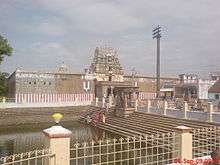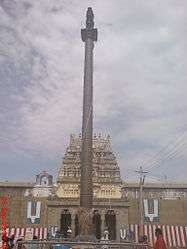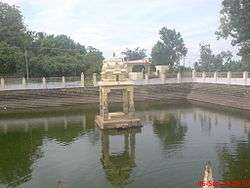Vijayaraghava Perumal temple
Vijayaraghava Perumal temple is a Vishnu temple in Thiruputkuzhi, a village in Kanchipuram district in Tamil Nadu, India. It is situated about 7 miles west of Kanchipuram and half a kilometre from Baluchetti Chattiram which lies on the Chennai - Vellore highway. Constructed in Dravidian style of architecture, the temple is glorified in the Divya Prabandha, the early medieval Tamil canon of the Azhwar saints from the 6th–9th centuries AD. It is counted as one among the 108 Divya Desams dedicated to Vishnu. Vishnu is worshiped as Vijayaraghava Perumal and his consort Lakshmi as Maragathavalli Thayar.
| Vijayaraghava Perumal temple | |
|---|---|
 | |
| Religion | |
| Affiliation | Hinduism |
| District | Kanchipuram |
| Deity | Vijayaraghavaswamy (Vishnu) Margathavalli Thayar (Lakshmi) |
| Location | |
| Location | Tamil Nadu, India |
| State | Tamil Nadu |
| Country | India |
 Location in Tamil Nadu | |
| Geographic coordinates | 12°52′21″N 79°37′08″E |
| Architecture | |
| Type | Dravidian architecture |
The temple is believed to be of significant antiquity and is believed to be initiated by the Pandyas, with later contributions at different times from Cholas and Thanjavur Nayaks. The temple has three inscriptions dating from the Chola period. The temple has a five-tiered rajagopuram (gateway tower) and enshrined within a granite wall. The complex contains all the shrines while the temple tank, is located to the west of the temple. The Brahmotsavam festival celebrated in the Tamil month of Masi (February - March), Theppotsavam (float fetival) in Thai (January - February) are the major festivals celebrated in the temple.
Architecture
The temple is believed to have been built by the Pandya kings during the 13th century, as seen from the stone inscriptions in the temple.[1] The temple here is one among the 108 Divya Desams and is dedicated to Lord Vijayaraghavaswamy (Moolavar). There is a separate temple for Thayar in the form of Margathavalli Thayar and a sannidhi for Sri Ramanuja. The central shrine houses the image of the presiding deity, Vijayaraghava sported with four hands. He is seen in a posture holding the bird Jatayu and performing the last rites. Sridevi and Bhudevi are sported alongside with their head facing earth. It is believed that the image is sported to indicate sorrow on the faces. Sridevi who is usually sported on the right side of Perumal is located to his left in this temple probably because of the sorrow created by the death of Jatayu. Ramanuja, the preceptor of Visishtadvaita philosophy had his early education at this temple.[2]
Legend
Jatayu, the eagle bird in Ramayana was killed by the demon king Ravana, while trying to save Sita during the abduction. Rama, the avatar of Vishnu and the hero of Ramayana, who was in search of his wife Sita arrived at this place. When Rama and Lakshmana went there in search of Sita, they find Jatayu mortally wounded in the forest.[3] The eagle Jatayu narrated the events to Rama before breathing his last. The presiding deity, Vijayaraghava Perumal is believed to have performed the last rites of Jataya at this place. The water body where Jatayu fell is called Jatayu Theertham.[1] Jatayu belongs to the Pul (a separate family of eagle) family and was buried in a pit (Tamil kuzhi), hence this sthalam is called Thiruputkuzhi. The eagle Jatayu narrated the events to Rama before breathing his last. The presiding deity, Vijayaraghava Perumal is believed to have performed the last rites of Jataya at this place. The water body where Jatayu fell is called Jatayu Theertham.[1] The same legend is also associated with Thirupullabhoothangudi Temple.[4]
Religious importance

The temple is revered in Nalayira Divya Prabandham, the 7th–9th century Vaishnava canon, by Thirumangai Azhwar in one hymn. The temple is classified as a Divyadesam, one of the 108 Vishnu temples that are mentioned in the book. Thiruputkuzhi is believed to be the birthplace of Yadava Prakaasa, the teacher of Vaishanava saint Ramanuja and also that of Pinpazhagiya Perumal Jeeyar. Vedanta Desika composed hymns praising the presiding deity. Thirumangai Azhwar has also reverred the temple in his verses.[1] The temple follows Pancharaktha Agama and the worship practises are carried out by hereditary priests belonging to the Porakathi Bhattar sect.[1]
Festival and religious practices
The temple priests perform the pooja (rituals) during festivals and on a daily basis. As at other Vishnu temples of Tamil Nadu, the priests belong to the Vaishnavaite community, a Brahmin sub-caste. The temple rituals are performed six times a day: Ushathkalam at 7 a.m., Kalasanthi at 8:00 a.m., Uchikalam at 12:00 p.m., Sayarakshai at 5:00 p.m., Irandamkalam at 6:00 p.m. and Ardha Jamam at 7:30 p.m. Each ritual has three steps: alangaram (decoration), neivethanam (food offering) and deepa aradanai (waving of lamps) for both Vijayaraghava Perumal and Maragathavalli. During the last step of worship, nagaswaram (pipe instrument) and tavil (percussion instrument) are played, religious instructions in the Vedas (sacred text) are recited by priests, and worshippers prostrate themselves in front of the temple mast. There are weekly, monthly and fortnightly rituals performed in the temple. The Brahmotsavam festival celebrated in the Tamil month of Masi (February - March), Theppotsavam (float fetival) in Thai (January - February), Pavitrotsavam in Avani and Vaikunta Ekadasi celebrated during the Tamil month of Margazhi (December–January) are the major festivals celebrated in the temple. Srisukta Homam, a religious practice, is performed in the temple with 108 lotus leaves on full moon days.[5]
References
- C., Chandramouli (2003). Temples of Tamil Nadu Kancheepuram District. Directorate of Census Operations, Tamil Nadu.
- M. S., Ramesh (1993). 108 Vaishnavite Divya Desams: Volume 1. Tirumalai-Tirupati Devasthanam. p. 109.
- K.V., Raman; T., Padmaja (1995) [1991]. "Indian Epic Values: Rāmāyaṇa and Its Impact : Proceedings of the 8th International Rāmāyaạ Conference". Peeters Publishers: 86. ISBN 978-9068317015. Cite journal requires
|journal=(help) - R., Dr. Vijayalakshmy (2001). An introduction to religion and Philosophy - Tévarám and Tivviyappirapantam (1st ed.). Chennai: International Institute of Tamil Studies. pp. 530–1.
- "Sri Vijayaragahava Perumal temple". Dinamalar. Retrieved 2 November 2019.
External
| Wikimedia Commons has media related to Thiruputkuzhi. |
- "Thiruputkuzhi - Sri Vijayaraghava Perumal Temple, Tirupukuzhi". Divyadesam.com. Retrieved 14 February 2010.
- "Thiruputkuzhi Sri Vijayaraghava Perumal Temple". Sri Vaishnavam Practices. Retrieved 14 February 2010.
